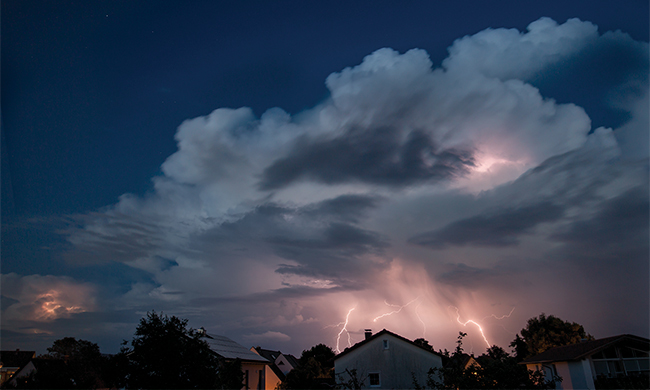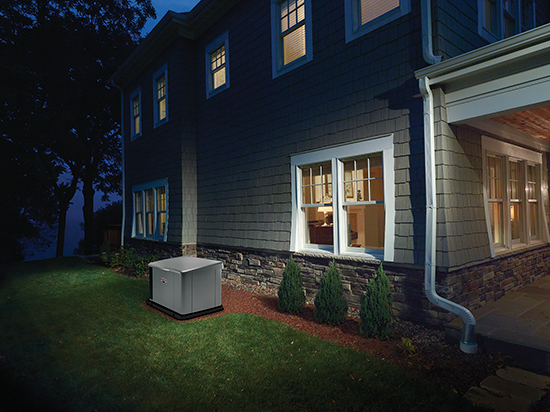Live Better
Weather the storm

Prepare early for power outages and other storm impacts
(Family Features) Surging spring temperatures can bring volatility that translates into major weather events. The 2020 storm season could see above-average probability for major hurricanes hitting the United States coastline and the Caribbean, according to the annual Colorado State Tropical Meteorology Forecast.
As those in the paths of seasonal storms know, property damage and power outages come with the territory. Being prepared for weather disasters and power outages is critical to protecting property, productivity and well-being.
Assess external threats. Before storm season arrives, take inventory of potential problems outdoors that could be exacerbated by bad weather. For example, trees may need trimming if limbs threaten power lines, the house or other structures on your property. Also examine the house for necessary repairs, such as loose guttering, shutters or shingles that may need to be secured and torn screens, all of which can worsen in heavy weather and cause more damage.
Another consideration is items that could topple in heavy winds, such as barbecue grills or lawn furniture. When possible, look for ways to secure these items so they don’t take flight, aren’t destroyed or cause additional damage.
Assemble emergency resources. An overnight storm is no time to discover your flashlight batteries are dead or you don’t have the right size batteries to replace them. Making time to update your stash of storm supplies before weather hits can save some frustration and help ensure you’re prepared to safely wait out the storm.
In addition to replacing flashlight batteries and checking that they’re in good working order, if you don’t have a light source in every room it’s a good plan to place flashlights or lanterns in rooms where you may need to be able to see in an emergency. The idea is to give everyone in the family the ability to illuminate their path and move safely through the house no matter where they are when the lights go out.
Part of your preparation should also include restocking your first-aid kit. Some items in the kit, like ointments and medications, can expire so you’ll need to replenish anything you’ve used and double-check that the contents are still safe to use. If you don’t already have them, be sure to add a battery-operated radio and a portable power bank so you have access to news updates and can charge a low phone battery.
Take inventory of your non-perishable food items to ensure you have plenty of options on hand in the event power stays off through one or more meals. You may also want to stockpile some books and board games for convenient access to entertainment while your power is down.
Make power plans. Because power outages area near certainty during severe weather season, reliable electricity is a necessity for powering work, school and daily life. An appropriately sized standby generator can ensure your home power doesn’t miss a beat when faced with seasonal storms. Because standby generators are fueled by natural gas or liquid propane, the tank doesn’t require regular refueling with gasoline which means no last-minute trips to the gas station when your generator runs out of gas.
“Standby generators can power an entire home, and because they are wired to the home’s electrical system so there is minimal interruption,” said Brian Northway, Briggs & Stratton field service manager. “When a storm knocks out power, the generator automatically takes over to deliver power, allowing you to take care of family and accomplish what you need to rather than worry about the power outage.”
Generators with a smart power management system, such as the line of units offered by Briggs & Stratton, can help manage high-wattage appliance priority. These power management technologies allow a homeowner to prioritize the power they need during an outage at a lower upfront acquisition cost.

How Big of a Generator Do You Need?
It can be easiest to determine which type of home standby generator system is right for your household by first thinking about what items your family needs to remain functioning normally during a power outage. The number of home appliances or electrical loads you want to power will determine the size and cost of the generator.
There are generally three different types of standby generators, which vary based on how much your home needs to power:
Select Circuit Home Generators: Power Essential Appliances
A select-circuit generator system is a cost-effective way to power your home’s basics to get you comfortably through a power outage. These units can power up to 10 electrical loads in your home, including the fridge, some lights, television and the microwave.
Managed Whole-House Power Generators: Smaller, More Power
A standby generator equipped with a smart power management solution gives your family the benefits of whole-house power with a smaller, more affordable generator system. These home generator systems can power all your electrical needs, including up to two
air conditioners.
Whole-House Generators: Maximum Backup Power Needs
Whole-house standby generator options are typically used as backup power solutions for extra-large and luxury homes. They power an array of high-wattage appliances, from double ovens to hot tubs with commercial-grade performance.
Learn more about standby power options at powernow.com.
Photo courtesy of Getty Images (Thunderstorm)
SOURCE:
Briggs & Stratton
Live Better
Laying the foundation for writing

(Family Features) Learning to write is one of the defining milestones of early childhood, but it doesn’t happen all at once. Children build writing skills over time, from indecipherable scribbles to writing letters and words. While children progress at their own pace, families can help foster early writing development.
Dr. Lauren Loquasto, senior vice president and chief academic officer at The Goddard School, and Dr. Sonia Cabell, professor of reading education at Florida State University and member of The Goddard School’s Educational Advisory Board, provide this insight and guidance for families.
Early Writing Milestones
Writing begins in early toddlerhood, around 18-24 months. The earliest developmental milestone is when children scribble on paper with a crayon.
By 2-3 years old, children often draw shapes and narrate their writing. Parents should show genuine interest to help build confidence and interest. Ask your children to read what they write, as this helps make the connection that marks on paper represent thoughts and ideas. It’s not expected for children younger than 3 to write identifiable letters. Instead, encourage them to make marks on paper without constraint, allowing them to freely express themselves.
Around ages 3-5, children begin to move from writing (making marks) to handwriting, which is the formalized motion of making numerals and letters in recognizable forms. It’s vital for parents to value their children’s writing no matter what appears on the paper and provide opportunities for them to regularly engage in writing. Children at this age tend to write letters in different ways. It’s common, for example, for letters to appear backwards or from right to left. These are not causes for concern; this is a natural part of the development process.
Writing Supports Reading (and Vice Versa)
Reading and writing skills develop in tandem, reinforcing each other. Through writing, children experiment with how written language works, learning English moves from left to right and top to bottom. By estimating spelling – using their knowledge of letter shapes and sounds to attempt to write words – they are beginning to break the code of reading. Moreover, when children are composing stories, they are supporting comprehension and oral language growth, which are critical for reading development.

Encourage Writing at Home
Make writing part of everyday life. While ensuring paper and writing utensils are accessible is a start, materials alone won’t spontaneously create writing experiences. Children naturally want to engage with things they see, so parents and older siblings should serve as writing models. For example, when writing a grocery list, ask your children to write their own lists. When you’re writing a thank-you note, have them write their own.
The development of fine motor skills is also essential. One way to do this is provide tools like chopsticks or tongs that require them to use their forefinger and thumb in a pinching motion; this strengthens the hand muscles that are used to write. Also encourage play with small toys like blocks or beads that engage the hands in different ways. As fine motor skills improve, it becomes easier to grip writing utensils and write for extended periods.
Writing Tools
From apps to workbooks, countless tools and resources tout their ability to help children learn to write. Be wary. Typing on a tablet or computer is no substitute for learning to write by hand. Multiple studies have shown that writing – not typing – better promotes cognitive and literacy development.
Avoid activities like workbooks that require repetitive writing of letters over and over, as this inhibits creativity and experimentation. These activities can cause children to fear making mistakes, which can lead to anxiety, frustration and a loss of interest. The best tools are often the simplest: a small writing utensil (not big or bulky; children have small hands and need appropriately sized utensils) and a blank piece of paper.
Remember, children develop at their own pace. Provide encouragement and focus on effort, not perfection.
To watch a writing webinar featuring Loquasto and Cabell and access additional parenting resources, visit the Parent Resource Center at GoddardSchool.com.
Photos courtesy of Shutterstock
SOURCE:
Live Better
Keep your summer entertaining simple, fun

5 expert ways to make the most of seasonal gatherings
(Family Features) From summer holidays and pool parties to spontaneous backyard barbecues with friends and neighbors, the hottest season of the year brings people together. When it’s your turn to host, make the most of the occasion by setting up your space to maximize the fun while showing off your festive side.
“Summer is hands down my favorite time to host,” said Kristina Zias, lifestyle, beauty and fashion expert and mom. “I love any excuse to bring people together and – let’s be real – I’m always looking for a reason to throw a party. The key is keeping things low stress for the host and making sure guests feel comfortable the second they walk in.”
This season, Zias and Glade are teaming up to share some of her favorite summer entertaining tips, which are simple, low-effort ways to make every gathering feel special. Whether you’re planning a full-blown backyard bash or hosting a few friends for drinks, Zias’ go-to ideas are all about setting the mood and enjoying the moment.
1. Set the Scene Without the Stress
To achieve a beautiful scene and make cleanup a breeze, try using disposable plates, utensils, napkins and cups in red, white and blue. A self-serve drink station with strawberry-infused water and a table of colorful fruit skewers adds charm without requiring much prep.

2. Tap Into Nostalgia Through Scent
Scent can instantly transport guests back to cherished summer memories, making it a powerful way to set the tone and spark conversation. Zias suggests using home fragrances to do just that. The new Glade Americana collection, available exclusively in stores and online at Walmart, features three limited-edition scents inspired by nostalgic summer traditions like beach trips, ice pops and garden-fresh fruit. Masterfully crafted to help bring summer to every room of your home, they’re designed to evoke warm-weather traditions.
- Berries & Cream: Scents of a classic American summer treat spring to life in a picnic-perfect blend of apple, red berries, apricot, vanilla and sweet cream.
- Summer Pops: Reminisce on childhood memories of a cool ice pop on a warm summer day with bright notes of Brazilian orange, pineapple, strawberry, white peach and sandalwood.
- Beach Life: Transport yourself to a favorite summer vacation spot by the ocean with a breezy mix of sea salt, driftwood, white moss and white peony.
“These seasonal scents can help you evoke nostalgic memories and bring that summer energy into any room of your home,” Zias said. “They make everything feel a little more special and, honestly, they just make me happy.”
3. Keep It Simple and Guest-Friendly
Part of summer’s appeal is its easygoing vibe, so there’s no need to overdo it with complicated snacks or overwhelming decor. Lean into the simplicity of the season with ready-to-serve bites that can please guests of all ages, like berries, sliced or cubed watermelon, meat and cheese trays, sliders or chips and light dips. A separate kids station with games and snacks can keep little ones entertained.
4. Create Comfortable Hangout Spots
The hot summer sun and cool indoor air means guests will likely filter in and out of the house, so help them feel welcome and comfortable wherever they may be. Consider flexible seating guests can move around on the patio or in the yard, like bag chairs or foldable lawn chairs. Complement your festive indoor drink station with beverage-filled coolers to keep guests refreshed and designate an area for essentials like sunscreen and bug spray.
5. Have a Backup Plan
The best-laid plans can go awry when summer storms pop up. Before inviting the entire town for a barbecue, make sure you have enough indoor space and seating in case of rain or extreme heat. For grilling plans, Zias recommends prepping an alternate cooking method to avoid last-minute stress. A little backup planning can help keep the good vibes going, rain or shine.
For more summer entertaining ideas, visit Glade.com.
Photo courtesy of Shutterstock (group of friends eating)
Photo courtesy of Glade (candles)
SOURCE:
Live Better
Physical movement can help fight chronic diseases

Physical activity is a valuable tool in the fight against chronic disease and other conditions. In fact, the Cleveland Clinic highlights physical activity among its nine ways to prevent disease in an effort to live a long and rewarding life.
Children, adolescents, young adults, and even men and women in middle age may not face too many physical hurdles when they try to exercise, but seniors are not always so lucky. Aging men and women with mobility issues may wonder if they can reap the rewards of physical activity, and thankfully there are many ways to exercise even if getting up and going isn’t as easy as it might have been in years past. Sometimes referred to as “aerobic exercise” or simply “cardio,” cardiovascular exercise is an umbrella term that encompasses a wide range of physical activities that raise the heart rate and improve endurance. Seniors with mobility issues can look to various forms of cardio for inspiration as they seek to be more physically active without compromising their overall health.
· Walk your way to a healthier you. Walking is a form of cardiovascular exercise that is ideal for older adults with mobility issues because it need not be physically demanding and it’s safe to walk just about anywhere. Walking in a place such as a local park can be particularly good for older adults because they can take periodic breaks on benches if aches, pains or stiffness is affecting their ability to keep moving.
· Take up swimming. Swimming might be tailor-made for seniors with mobility issues because it’s a great workout and exercising in water tends to be less taxing on muscles and joints. The Cleveland Clinic notes that swimming promotes heart health, strengthens the lungs, helps to burn calories, and builds muscle, among other benefits. And many seniors find swimming is just as fun in their golden years as it was in their youth, which means aging adults might not face problems with motivation when the time comes to get in the pool.
· Use an exercise bike or portable pedal exerciser. Cycling is a wonderful exercise but one that seniors with mobility issues may feel is no longer possible. If doctors advise against riding a traditional bike, an exercise bike or portable pedal exerciser can provide many of the benefits of cycling without as great a risk for accident or injury. A portable pedal exerciser can be carried to a park, where seniors can still spend time in the great outdoors, which is one of the most appealing reasons to get on a bike and go.
· Take beginner yoga or tai chi. HelpGuide.org notes that gentle yoga or tai chi can help to improve flexibility and reduce stress and anxiety. Though yoga and tai chi can provide as much demanding physical activity as individuals allow, beginner classes in each discipline don’t require much movement but do provide enough for seniors hoping to be less sedentary.
Even seniors with mobility issues can find safe and effective ways to be more physically active. Prior to beginning a new exercise regimen, seniors with mobility issues are urged to discuss activities with their physicians.
-

 NEWS3 years ago
NEWS3 years ago2 hurt, 1 jailed after shooting incident north of Nocona
-

 NEWS2 years ago
NEWS2 years agoSuspect indicted, jailed in Tia Hutson murder
-

 NEWS2 years ago
NEWS2 years agoSO investigating possible murder/suicide
-

 NEWS2 years ago
NEWS2 years agoWreck takes the life of BHS teen, 16
-

 NEWS2 years ago
NEWS2 years agoMurder unsolved – 1 year later Tia Hutson’s family angry, frustrated with no arrest
-

 NEWS2 years ago
NEWS2 years agoSheriff’s office called out to infant’s death
-

 NEWS2 years ago
NEWS2 years agoBowie Police face three-hour standoff after possible domestic fight
-

 NEWS3 years ago
NEWS3 years agoDriver stopped by a man running into the street, robbed at knifepoint






